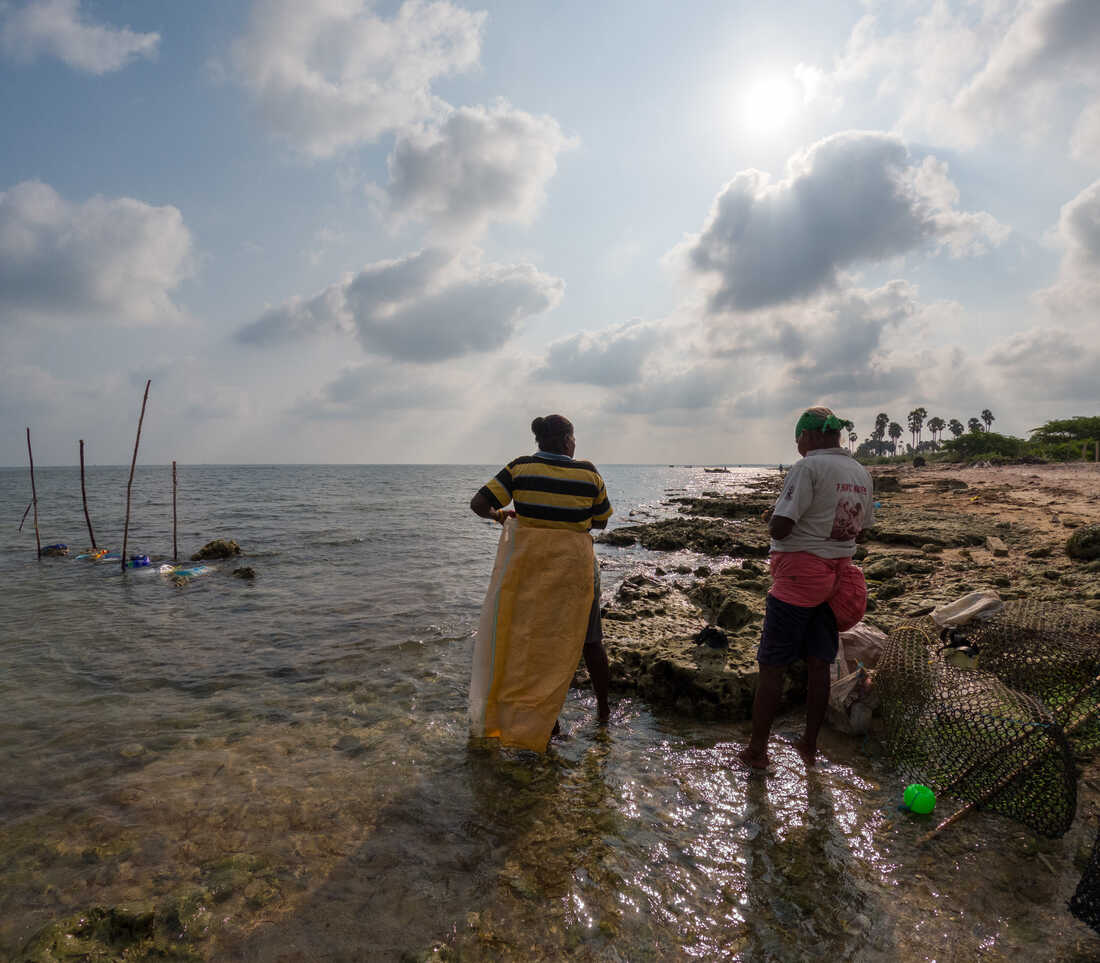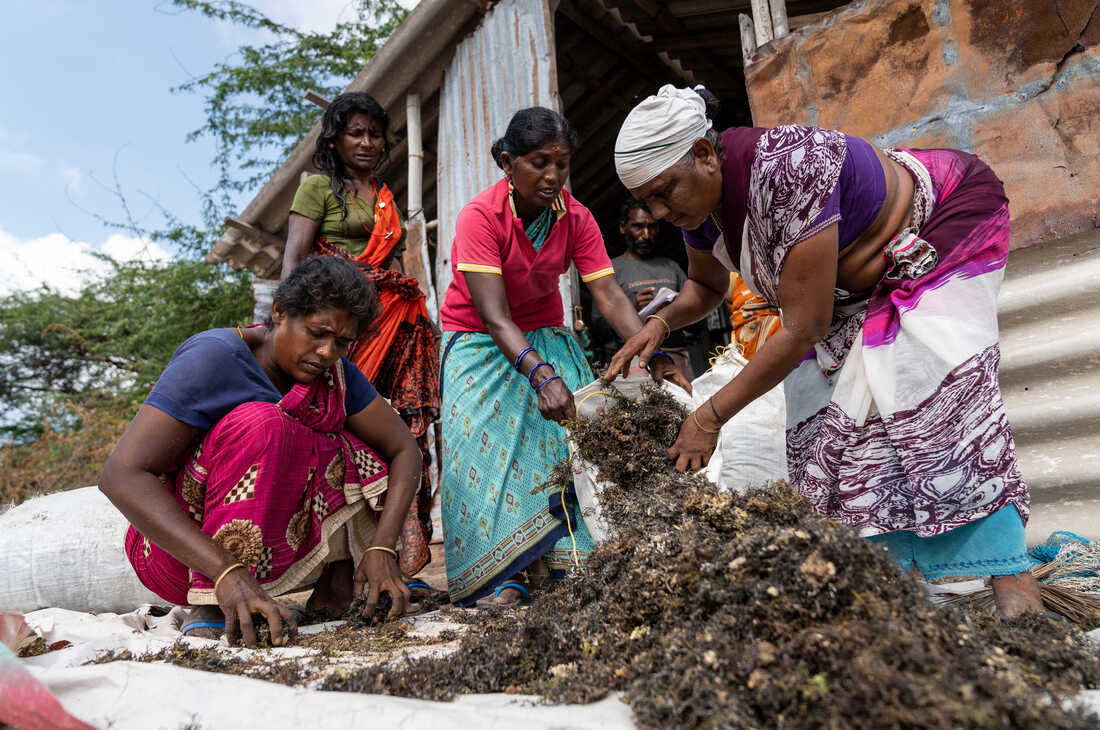By Kamala Thiagarajan

Thangamma, about 80 years old, gathers seaweed off Pananthoppu
beach, Pamban island, Tamil Nadu, India. Seaweed extracts are used
in a booming global food industry. An estimated 5,000 women gather
seaweed in the shallow reefs around Pamban island, which they sell
to local factories.
Early on a warm February morning, a group of ten women, ranging in age from 50 to 60, sit on the sandy shores of Akkal Madam beach on India’s Pamban Island, carefully bandaging their fingers. Wearing colorful blouses and saris, they wind thick strips of cloth over each digit and secure the ends with string. It takes them over 20 minutes.
The bandages, they’ve found, are the best way to protect hands from sharp rocks on the seabed when they go underwater to dive for seaweed, which they sell to a local factory.
“This is how we get ready,” says Bhagavathy. “We’ve tried gloves before, but they always slip away in the strong currents. And injuries are so common when your fingers are exposed.”

Bhagavathy shows the seaweed she collected. The divers hold
their breath for 2 to 3 minutes while extracting seaweed from underwater rocks.
Bhagavathy knows what she’s talking about. Now in her mid-60s, she has been collecting seaweed since she was 7.
(Like the other seaweed divers interviewed for this story, she prefers to be referred to by her first name only, as is the custom in these parts).
To keep the rocks from tearing at their feet, the women wear rubber slippers. They strap on goggles since they’ll be underwater with frequent dives each lasting up to 2-3 minutes over a 5-6 hour day. They’re mastered the art of holding their breath during these dives.

Thangamma, about 80 years old, dives in to gather seaweed.
“It’s not for the faint-hearted. That’s why you won’t see any men here,” Bhagavathy jokes. The other women laugh as they wade into the warm waters.
But modern times and modern problems have made it harder to succeed in this old-fashioned occupation. A growing number of marine heat waves are causing a dropoff in the types of seaweed they gather. What’s more, the government now prohibits seaweed extraction in some areas to promote ocean health.
These women also face challenges on the homefront. Alcoholism among husbands and other male family members is a serious problem.

As Thangamma and Bhagavathy eat the meal they packed before
leaving home in the early morning hours, more women arrive at
Pananthoppu beach to dive for seaweed.
Nonetheless, an estimated 5,000 women from the region persist, determined to continue diving for seaweed.
“It’s our main source of livelihood,” says Munniammal, who’s in her mid-50s. “Our grandmothers and great-grandmothers have accompanied their husbands on fishing expeditions to collect seaweed as far as we can remember. It’s a tradition as much as it is our livelihood.”
Pamban, where the women collected seaweed that February morning, is a teardrop-shaped island known for its rich marine ecosystem. With over 4,000 species of plants and animals, it’s considered by UNESCO to be one of the world’s most bio-diverse hotspots.

Boats off the beach at Chinnapalam village, Pamban island, Tamil Nadu, India.
The island is positioned between peninsular India and Sri Lanka, connected to the Southern Indian state of Tamil Nadu via a rail and road bridge that stretches over a mile and a half across the waters of the vast Indian Ocean. Eucalyptus, coconut and palm trees abound, and wooden fishing boats bob on turquoise waters as far as the eye can see.
There are no fishing boats on this particular beach, however; Akkal Madam is a deserted strip of baked sands at 8 a.m. when the women arrive after a 3-mile auto taxi ride from their village of Chinnapalam. A wild wind whips through their hair, and the sunlight is blinding.

Bhagavathy (left) and Thangamma (right) get ready to gather seaweed.
“It’s not for the faint-hearted. That’s why you won’t see any men here,”
Bhagavathy jokes.
The women who have gathered to collect seaweed in the shallow reefs tie white gunny sacks around their hips and plunge into the waters. They pluck at sprigs of springy seaweed, freeing them from the sharp rocks they grow on. They surface briefly and with one deft flick of the wrist throw the sprigs into the sacks tied to their waists. With hardly a backward glance they plunge into the waters again. From 8 a.m. until 3 p.m. they are mainly underwater.
Most of them wear shirts or t-shirts over their saris so their wet clothes don’t cling to them; the additional layer adds warmth. The strips of sari fabric thrown over the left shoulder streams behind like brightly colored flags as the divers slice through the waves. The water is cloudy because of frequent bouts of nitrogen and phosphorus, pollution that causes the growth of algae. The currents are strong, even on this nice sunny day.

On the beach on Pamban island, the seaweed gatherers go out only 12 days every month, collecting a week after the new moon and a week before the full moon. This is when the tides are weaker, the waters gentler and more conducive for seaweed gathering. There’s a gap of nine days between cycles to allow the seaweed to regenerate.
In synch with the moon and the sea
Like anyone who depends on the sea for a living, the seaweed divers are exquisitely tuned into their natural surroundings.
On the beach on Pamban island, they set their own rhythm, harvesting seaweed only 12 days every month, their schedule governed by the lunar cycle. They collect a week after the new moon (roughly mid-month) and a week before the full moon (toward the end of the month). This is when the tides are weaker, the waters gentler and more conducive for seaweed gathering. There’s a gap of nine days between cycles to allow the seaweed to regenerate.

Other seaweed gatherers from Chinna Palam who are younger and more able, have a different working style.
They don’t just gather seaweed by the coast. As their foremothers did, the women collect seaweed further out at sea, off the coast of 21 uninhabited islets scattered like gems between Pamban and Sri Lanka. These islands now make up the Gulf of Mannar Marine National Park. The seaweed haul here is richer, especially around the coral reefs. They make double the income of those who gather seaweed by the coast. Since they must pool their money to hire boats for this expedition, they go out to sea only six times a year and leave the seaweed that grows around Pamban island for older women to harvest.
Small groups set out around 5 a.m., sharing a motorboat.
Their workday begins much before the crack of dawn, says Seeniammal, who is spreading the seaweed she gathered to dry just outside her home. That morning, she woke up at 3 a.m., made herself tea, prepared a meal for her husband and her granddaughter who lives with her and packed some rice for lunch on the boat.
By 5 a.m., she is accompanied by four other women on a motorboat, operated by a fisherman they know well. They each chip in about $1 for the ride. It’s a half-hour journey to the nearest island. Depending on the availability of seaweed, they may venture out to the other islands that are further away. Once they find the best spot, they moor the boat and dive in. The women are in neck deep waters usually until 3 p.m., because the strong currents would disrupt the work after that. Seeniammal gathered about 22 pounds of seaweed from that single trip, she says, almost double what women collect near the coast of Pamban.

A seaweed gatherer removes unwanted particles from the dried
seaweed before it is weighed and sold.
They usually make about $6 a day – compared to $3 to $4 for the women who stay on the island’s coast.
No matter where the seaweed is collected, the process of selling it is the same. Once the women return to their village, the seaweed is carefully weighed by representatives of local factories. Much haggling occurs.

Weighing the seaweed in Chinnapalam village, Pamban island, Tamil Nadu.
Risks galore: poison fish, dizziness, human attackers, new laws
Holding on to this traditional way of earning a living poses many risks.
Poisonous fish abound in the coral reefs nearby.
“A few years ago, a poisonous fish sunk its thorns into me,” says Seeniammal. “It hides in the coral reefs, so we can’t ever spot it underwater. The pain is so excruciating, you’ll wish you were dead. I was rushed to the hospital and treated with an injection, but I was weak and disoriented for weeks afterward.”
The stonefish that is suspected to have stung Seeniammal is a well-known venomous reef fish with 13 venomous spikes. Other women chime in that they must constantly watch out for poisonous fish and stinging jellyfish.
There are other dangers. The women dive in small groups so they can look out for each other. Three months ago, a 50-year-old seaweed collector from a nearby village was raped and killed on an isolated beach.
The women also report that they sometimes grow dizzy while diving. If there’s any kind of accident, the seaweed collectors who travel by boat to their harvest spots must all return so the injured person can be treated. That means a loss of income, but, says Bakyam, age 40, it’s part of an unspoken pact: “We constantly watch out for each other.”
Then there are the legislative roadblocks. In 1986, the government established the Gulf of Mannar Marine National Park. Seaweed extraction in the protected waters of the reserve was declared illegal, with a jail term of three years for violators.
S. Mahendran, a Forest Range officer in the nearby town of Mandapam who is familiar with the women seaweed divers, says there’s a reason these restrictions existed.
“The islands are very fragile, eco-sensitive zones,” he says. “There is a buffer area of six to seven meters around each island to protect the coral reefs there. And any footfall on the island itself could pose a risk to its vegetation, particularly its medicinal plants and wild grass.”
The women are allowed to collect seaweed if they don’t breach that buffer zone, he says. But since the seaweed grows so close to the islands, that’s a thin line and not always possible, the women say.
So that restriction doesn’t stop the women, says Pandiammal, who is the head of the local village council. “We tell authorities that it’s our right to do so. We don’t know any other way to live.”
Rocky lives above water too
I interviewed nearly 50 seaweed-gathering women. They had one overriding concern about their lives when they were out of the water: the men in their community. They’re primarily fishermen – and, the women say, many of them are addicted to alcohol.
“Both men and women struggle to make a living. But the men tend to squander away hard-earned money on liquor,” Pandiammal says. “It’s made our lives above water as rocky as the seabed we face all the time.”
So fishing income earned by the men is squandered — putting pressure on the women to dive for more seaweed to make up for a husband’s lost income.
“Alcohol addiction is a huge problem in these parts and one that authorities are constantly battling,” says the forest officer Mahendran. “I truly admire the courage of these women. They must bear the burden of all the expenses after their husbands, who earn a good living, have frittered away their money on drinks.”
Many women say that the addiction grows worse from April 15 to June 15, during the state’s 45-day ban on mechanized boats, used by fishermen, so breeding season is not interrupted. Even the seaweed gatherers stay home so as not to disturb the marine life. The state government gives each family about $60 to compensate for the loss of the men who fish. But a woman’s income is not taken into account because a female labor force is largely invisible in a patriarchal country like India and a cash strapped state government battling a deficit can’t likely afford more, says Mahendran.

Children in Chinnapalam village, home to women seaweed divers.
Changes for the worse — and the better
About 30 years ago, a plan was hatched to help the women.
In the 1990s, the Central Salt and Marine Chemicals Research Institute, a part of India’s Council of Scientific and Industrial Research, had the idea that teaching the women to farm seaweed would be not only less dangerous than collecting but more lucrative.
An agreement was forged with for-profit companies to cultivate a non-native species called Kappaphycus alvarezii, found in similar water in the Philippines.
Hundreds of rafts were set up close to the coast of Pamban island, laden with seaweed.
However, data from underwater photography taken since 2000 and published in the journal Current Science in 2008, revealed that the cultivated species has become invasive, smothering coral reefs in the protected reserve.

An effort to give women a new way to earn income involved
cultivating an imported type of seaweed on rafts. But the
species has reportedly become invasive, smothering reefs.
An extensive open survey is required to establish whether the species is indeed invasive, says Vaibhav A. Mantri, senior principal scientist at CSIR-Central Salt and Marine Chemicals Research Institute. “There are contrary views on this subject,” he says.
So while the jury is out on seaweed cultivation, the army of seaweed collectors have seen changes for the better. India’s Recognition of Forest Rights Act of 2006, recognizes the rights of indigenous communities to make use of natural resources, and seaweed divers are now being issued ID cards by the state’s Fisheries Department. One of the objectives of this act is to “undo the historical injustice that occurred” to indigenous communities and to “empower them to use resources in the manner that they were traditionally accustomed.”

A seaweed farmer reseeds Kappaphycus alvarezii, a species of
seaweed that is cultivated on rafts.
A hundred women seaweed divers from Chinna Palam should receive ID cards later this month – Indian bureaucracy is blamed for the delays. That will enable them to collect seaweed anywhere without concern for the repercussions. All they would need to do to qualify is to prove that they’re members of the community that’s been collecting seaweed for generations. It’s a truce of sorts between the indigenous people who have loved and lived on these islands for four generations — and a government’s efforts to secure the marine reserve, says Mahendran.
“For us, it’s validation that we don’t destroy the islands,” says Pandiammal. “We protect them. If it weren’t for these islands, how could we live?”
Kamala Thiagarajan is a freelance journalist based in Madurai, Southern India. She reports on global health, science and development, and her work has been published in the New York Times, The British Medical Journal, BBC, The Guardian and other outlets. You can find her on twitter @kamal_t
Originally published in NPR, Anushree Bhatter



